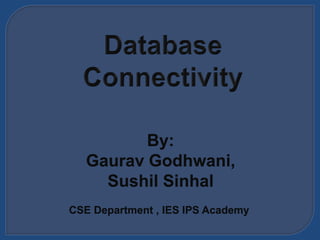
Jdbc Ppt
- 1. By: Gaurav Godhwani, Sushil Sinhal CSE Department , IES IPS Academy
- 2. Before APIs like JDBC and ODBC, database connectivity was tedious: > Database vendor provided function libraries for database access. > Connectivity library was proprietary. > Data access portions had to be rewritten with changes in the application. > Application developers were stuck with a particular database product for a given application
- 3. > Write once, run anywhere > Multiple client and server platforms > Object-relational mapping > databases optimized for searching/indexing > objects optimized for engineering/flexibility > Network independence > Works across Internet Protocol > Database independence > Java can access any database vendor > Ease of administration
- 4. > A standard or open application programming interface (API) for accessing a database > Developed by SQL Access Group, chiefly Microsoft, in 1992 > Access to various kinds of Databases > Allows programs to use SQL requests that will access databases without knowledge of the proprietary interfaces to the databases > Handles these requests and converts it into a request understandable by an individual database system.
- 5. > An ODBC software for a particular OS. > A separate module or driver for each database to be accessed > Driver masks the heterogeneity of DBMS, operating system and network protocol. > Ex: Sybase Driver, Windows Driver, etc.
- 7. > Java API for connecting programs written in Java to the data in relational databases > The standard defined by Sun Microsystems, allowing individual providers to implement and extend the standard with their own JDBC drivers. > Tasks of JDBC: 1) establishes a connection with a database 2) sends SQL statements 3) processes the results
- 8. > The JDBC API supports both two-tier and three-tier models for database access. > Two-tier model -- a Java applet or application interacts directly with the database. > Three-tier model -- introduces a middle-level server for execution of business logic: > the middle tier to maintain control over data access. > the user can employ an easy-to-use higher-level API which is translated by the middle tier into the appropriate low-level calls.
- 9. Java Application JDBC driver manager JDBC/native bridge DBMS Native driver (DBMS specific) JDBC/ODBC bridge ODBC Driver JDBC middleware (various DBMS) JDBC Driver (DBMS Specific)
- 10. > Class-I: JDBC:ODBC ( mainly for Desktop Applications) > Use bridging technology > Requires installation/configuration on client machines > Not good for Web > Class-II: Native API Drivers (Vendor Specific drivers) > Requires installation/configuration on client machines > Used to leverage existing CLI libraries > Usually not thread-safe > Mostly obsolete now > e.g. Intersolv Oracle Driver, WebLogic drivers
- 11. > Class-III: Network API > Calls middleware server, usually on database host > Very flexible & allows access to multiple databases using one driver > Only need to download one driver > But it’s another server application to install and maintain > e.g. Symantec DBAnywhere > Class-IV: Network Protocol Driver (used for Network based Applications) > Pure Java Drivers > Use Java networking libraries to talk directly to database engines > need to download a new driver for each database engine > e.g. Oracle, MySQL
- 13. Query Close Connect Process results Register the driver Connect to the database
- 14. Close Connect Query Create a statement Process results Query the database
- 15. Close Query Step through the results Process results Assign results to Java variables Connect
- 16. Connect Query Process results Close Close the result set Close the statement Close the connection
- 24. Thank You !!!
